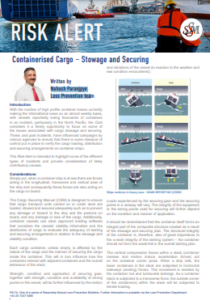Following several container losses and with vessels reportedly losing thousands of containers in an incident, particularly in the North Pacific, Steamship Mutual issued a risk alert focusing on issues associated with cargo stowage and securing.
According to the club, when a container ship is at sea there are forces acting in the longitudinal, transverse and vertical axes of the ship and consequently these forces are also acting on the cargo on board.
Therefore, the Cargo Securing Manual (CSM) is designed to ensure that cargo transport units carried on or under deck are loaded, stowed and secured adequately such as to prevent any damage or hazard to the ship and the persons onboard, and any damage or loss of the cargo.
[smlsubform prepend=”GET THE SAFETY4SEA IN YOUR INBOX!” showname=false emailtxt=”” emailholder=”Enter your email address” showsubmit=true submittxt=”Submit” jsthanks=false thankyou=”Thank you for subscribing to our mailing list”]
As Nahush Paranjpye from Steamship Mutual Loss Prevention Department explained, each cargo container, unless empty, is affected by the nature of the cargo and the manner of securing the cargo inside the container.
In fact, this will in turn influence how the containers interact with adjacent containers and the overall behaviour of the stack.
“A combination of factors such as the stowage plan, condition and strength of the various elements of this composite structure, vessels stability condition, environmental conditions and ship handling will all have a collective impact on the effectiveness of the cargo stowage and securing”.
…Nahush Paranjpye added.
When planning effective stowage and securing, it should be remembered that:
Container fitness
- Type / Purpose / Specifications
- Verification of CSC plate (safety limits – payload, stacking load, racking force)
It is recognised that while being loaded or when stowed at a high tier it may not be possible for the ship’s crew to perform a close-up inspection of every container. However, even from a distance, visually conspicuous conditions that might indicate potential issues should be discernible.
Visual monitoring could pre-empt risks due to:
- structural damage to container frame (including corner posts, cross members, top/bottom/side/end rails, corner fittings, forklift pockets).
- visible signs of significant corrosion / deterioration in plate thickness of strength members.
- side/back wall panels – bulged, torn, temporary patches or other signs such as leaks, spills that may be indicative of a structural failure or poor stuffing and securing of cargo within the container.
Cargo stowage and securing
- Stack load / Maximum load (tank-top/hatch cover/deck plate)
- Load distribution / Centre of gravity
- Windage area / Wind load / Pyramid stack
- Streamlined vs unbalanced cargo distribution – Stack interactions / Isolated Tall Stacks / Exposed Stacks / Heavy over light
- Stack weight
- Racking stress
- Securing arrangements – sufficient availability
- Correct application of lashings (such as following the lashing plan correctly, position and tightness of turnbuckle check nuts, proper rigging (no overloading of securing points)
- Lashing patterns and wind lashing
Stability condition
- Metacentric height (GM)
- Roll period
- Deadweight / Draught / Trim / Propeller immersion
Voyage planning
- Forecast
- Weather routeing and Passage planning
- Allowances for environmental conditions such as ice accretion
Effects of Speed, motion, vibrations & accelerations such as:
- Roll, Sway, Pitch, Surge, Yaw, Heave
- Parametric rolling
- Resonance frequency
- Whipping or springing accelerations
- Hull vibrations and effect on lashing gear
- Lifting forces
Explore Steamship Mutual’s Risk Alert herebelow
































































